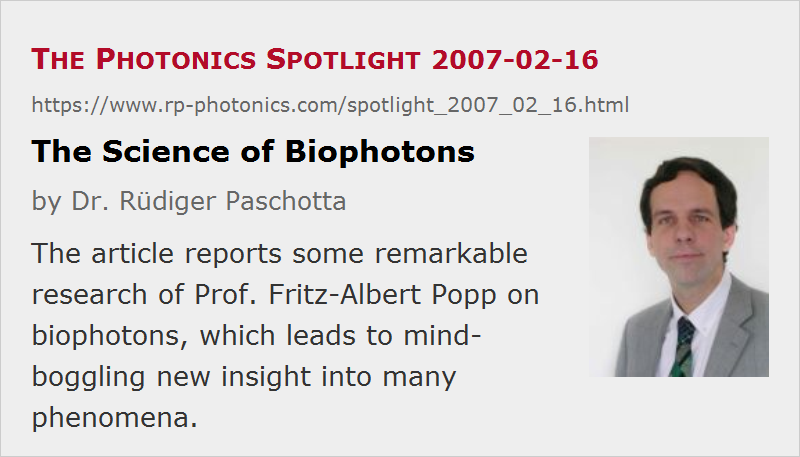The Science of Biophotons
Posted on 2007-02-16 (revised on 2011-05-09) as a part of the Photonics Spotlight (available as e-mail newsletter!)
Permanent link: https://www.rp-photonics.com/spotlight_2007_02_16.html
Author: Dr. Rüdiger Paschotta, RP Photonics Consulting GmbH
Abstract: The article reports some remarkable research of Prof. Fritz-Albert Popp on biophotons, which leads to mind-boggling new insight into many phenomena.

A few years ago I read a book by Prof. Fritz-Albert Popp. It is in German, titled “Die Botschaft der Nahrung” (“The Message of Food”), and is very much inspired by the discovery of biophotons. There is also a number of other publications of Popp on biophotons, including some material which can easily be found on the Internet (see e.g. the article "About the Coherence of Biophotons (1)").
To begin with, these biophotons really exist; they are photons emitted by living organisms, i.e. bioluminescence. While a few organisms, such as certain deep sea fish, emit quite considerable intensities (thus being easily visible), much lower levels of light, which can just be detected e.g. with photomultipliers, can be found in all kinds of other living beings. Concerning all the rest, I leave to the readers to decide whether they want to believe that.
Invisible radiation is known to be very inspiring, and that particular case is really entertaining. To get the flavor, consider some of the presented statements:
- The coherence of biophotons is derived from a Poissonian photon number distribution, with some additional coincidence measurements. I think that people being familiar with quantum optics might have some difficulties with the details, but never mind, they might just be too tied up with mainstream physics. Anyway, it doesn't even have to be disturbing if you ever find non-Poissonian statistics, since biophotons can even exhibit squeezed states of light.
- It is known that food supplies organisms with exergy, which is essentially energy which is associated with less entropy than e.g. the thermal energy in our surroundings. Low entropy is associated with order. And Popp sees biophotons of food as conveying order to the consuming organism. He goes as far as saying that high quality food is not primarily a chemical supply of energy, but rather transporting oscillations in the form of biophotons which decrease the entropy of the organism. It is just apparently a bit difficult to present any evidence for this.
- Consequently, the most proper methods for the analysis of food quality must be based on measurements of biophotons. One can learn e.g. about the ability of some substance to store light (and thus order), its potential to supply the most needed frequencies to an organism, etc.
- Popp found that the cells of our organism are probably communicating with light (→ optical data transmission), further confirming the idea that biophotons convey order and information, as well as finally explaining the amazing order of living organisms. He (or was it some colleague, I am not absolutely sure) sees the broadband nature of biophotons (spanning a wavelength range of hundreds of nanometers) as supporting this, stating that only this broadband nature makes it possible to focus this light to small things such as single cells! (This is very plausible, as a narrow-linewidth laser diode such as one of those built into DVD players could never be focused to a small spot, right?)
- Some people feel that we should better go a bit further and assume that all living beings are somehow connected via dynamic biophoton fields.
Looking e.g. at the above quoted article on the coherence of biophotons, you will find that it looks very scientific indeed, with well-known equations, various diagrams, acronyms, references, etc. Some of that material has been published in well-known journals. (Does that remind me of Sokal?) Additional credibility is derived from citing famous researchers such as Ilya Prigogine, Erwin Schrödinger, and others. So you should probably consider yourself as a fool if you still have any doubts. And who knows, by eating a fly which has been sitting on your computer screen for a while you may be able to incorporate a part of the information of the Encyclopedia of Laser Physics and Technology… If not, the limited bandwidth of the emitting phosphors of your screen may offer an explanation: this artificial kind of radiation may not have been able to hit the fly with sufficient order and precision.
Perhaps I should also mention that of course one should assess the credibility and quality of every bit of research on biophotons on its own, rather than developing a generalized opinion on the whole field.
This article is a posting of the Photonics Spotlight, authored by Dr. Rüdiger Paschotta. You may link to this page and cite it, because its location is permanent. See also the RP Photonics Encyclopedia.
Note that you can also receive the articles in the form of a newsletter or with an RSS feed.
Questions and Comments from Users
Here you can submit questions and comments. As far as they get accepted by the author, they will appear above this paragraph together with the author’s answer. The author will decide on acceptance based on certain criteria. Essentially, the issue must be of sufficiently broad interest.
Please do not enter personal data here; we would otherwise delete it soon. (See also our privacy declaration.) If you wish to receive personal feedback or consultancy from the author, please contact him e.g. via e-mail.
By submitting the information, you give your consent to the potential publication of your inputs on our website according to our rules. (If you later retract your consent, we will delete those inputs.) As your inputs are first reviewed by the author, they may be published with some delay.
 |



If you like this page, please share the link with your friends and colleagues, e.g. via social media:
These sharing buttons are implemented in a privacy-friendly way!